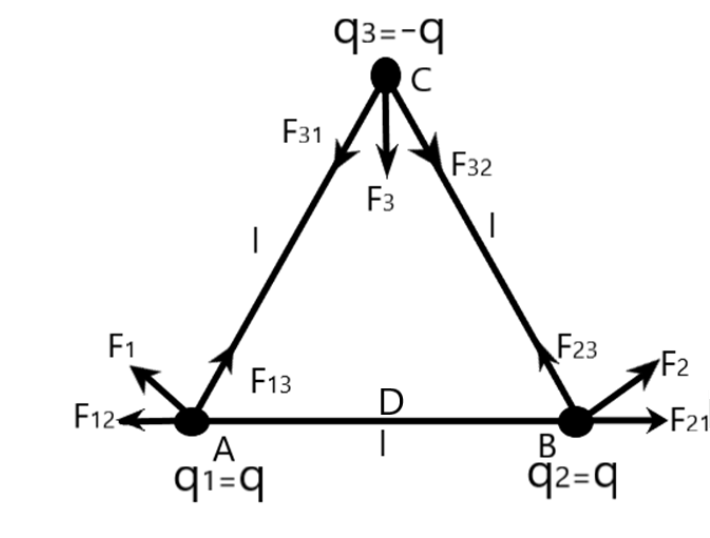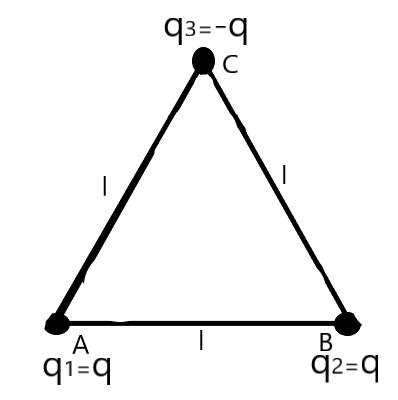Answer
405.3k+ views
Hint: We need to analyze the charges in the three corners of the equilateral triangle. The charges, the signs of the charges, and the distance between them determine Coulomb's force that will act between two of the charges in the system.
Complete step-by-step solution
Let us consider the given system of charges. We know that the direction of force acting on a charge due to another charge is dependent on the sign of the charge of the two under consideration. We know that the like charges repel and the unlike charges attract. So, we can draw the figure marking the forces due to the other charge and the resultant of two forces.

From the figure, we understand the direction in which the forces act on each of the charges. The forces \[{{F}_{1}},{{F}_{2}}\text{ and }{{F}_{3}}\] are the resultant forces acting on the charges \[{{q}_{1}},{{q}_{2}}\text{ and }{{q}_{3}}\] respectively due to each of the other charges.
Now, we can find the magnitude of the force acting on the charges. We know that the distance between all the charges are equal and they have equal magnitudes of charge. Therefore, the Coulomb’s force acting on each charge will be the same, which is given as –
\[\begin{align}
& F=\dfrac{1}{4\pi {{\varepsilon }_{0}}}\dfrac{qQ}{{{r}^{2}}} \\
& \text{here,} \\
& r=l \\
& q=Q=q \\
& \therefore F=\dfrac{1}{4\pi {{\varepsilon }_{0}}}\dfrac{{{q}^{2}}}{{{l}^{2}}} \\
\end{align}\]
We understand that each of the charges in the system has a force which is equal to \[F=\dfrac{1}{4\pi {{\varepsilon }_{0}}}\dfrac{{{q}^{2}}}{{{l}^{2}}}\] with the directions as described by the figure above.
Now, we can compute the total force acting in the system of charges. We know that the forces \[{{F}_{1}}\text{ and }{{F}_{2}}\] can have a result as shown below.

We can understand from the above figures that the forces due to charges at A and B have a resultant force of F’. The magnitude of F’ is given as –
\[\begin{align}
& F'=\sqrt{{{F}_{1}}^{2}+{{F}_{2}}^{2}+2{{F}_{1}}{{F}_{2}}\cos \theta } \\
& \Rightarrow F'=\sqrt{2{{F}^{2}}+2{{F}^{2}}\cos {{60}^{0}}} \\
& \Rightarrow F'=\sqrt{2{{F}^{2}}+2{{F}^{2}}(\dfrac{1}{2})} \\
& \Rightarrow F'=\sqrt{3{{F}^{2}}} \\
& \therefore F'=\sqrt{3}F \\
\end{align}\]
Now, since the force F’ and \[{{F}_{3}}\] are acting in the opposite directions, the net force acting in the system can be found as –
\[\begin{align}
& {{F}_{net}}=F'-{{F}_{3}} \\
& \Rightarrow {{F}_{net}}=\sqrt{3}F-F \\
& \Rightarrow {{F}_{net}}=(\sqrt{3}-1)F \\
& \text{but,} \\
& F=\dfrac{1}{4\pi {{\varepsilon }_{0}}}\dfrac{{{q}^{2}}}{{{l}^{2}}} \\
& \therefore {{F}_{net}}=\dfrac{1}{4\pi {{\varepsilon }_{0}}}\dfrac{{{q}^{2}}}{{{l}^{2}}}(\sqrt{3}-1)N \\
\end{align}\]
The direction of the force will be in the direction of DC. The resultant force is acting in the system along the direction of DC. This is the required solution.
Note: The forces acting in the directions as given by the figure describes that the system can be in equilibrium in this condition even if the charges involved are not the same. The total force acting in the system is zero as the forces between the unlike and like pairs cancel off.
Complete step-by-step solution
Let us consider the given system of charges. We know that the direction of force acting on a charge due to another charge is dependent on the sign of the charge of the two under consideration. We know that the like charges repel and the unlike charges attract. So, we can draw the figure marking the forces due to the other charge and the resultant of two forces.

From the figure, we understand the direction in which the forces act on each of the charges. The forces \[{{F}_{1}},{{F}_{2}}\text{ and }{{F}_{3}}\] are the resultant forces acting on the charges \[{{q}_{1}},{{q}_{2}}\text{ and }{{q}_{3}}\] respectively due to each of the other charges.
Now, we can find the magnitude of the force acting on the charges. We know that the distance between all the charges are equal and they have equal magnitudes of charge. Therefore, the Coulomb’s force acting on each charge will be the same, which is given as –
\[\begin{align}
& F=\dfrac{1}{4\pi {{\varepsilon }_{0}}}\dfrac{qQ}{{{r}^{2}}} \\
& \text{here,} \\
& r=l \\
& q=Q=q \\
& \therefore F=\dfrac{1}{4\pi {{\varepsilon }_{0}}}\dfrac{{{q}^{2}}}{{{l}^{2}}} \\
\end{align}\]
We understand that each of the charges in the system has a force which is equal to \[F=\dfrac{1}{4\pi {{\varepsilon }_{0}}}\dfrac{{{q}^{2}}}{{{l}^{2}}}\] with the directions as described by the figure above.
Now, we can compute the total force acting in the system of charges. We know that the forces \[{{F}_{1}}\text{ and }{{F}_{2}}\] can have a result as shown below.

We can understand from the above figures that the forces due to charges at A and B have a resultant force of F’. The magnitude of F’ is given as –
\[\begin{align}
& F'=\sqrt{{{F}_{1}}^{2}+{{F}_{2}}^{2}+2{{F}_{1}}{{F}_{2}}\cos \theta } \\
& \Rightarrow F'=\sqrt{2{{F}^{2}}+2{{F}^{2}}\cos {{60}^{0}}} \\
& \Rightarrow F'=\sqrt{2{{F}^{2}}+2{{F}^{2}}(\dfrac{1}{2})} \\
& \Rightarrow F'=\sqrt{3{{F}^{2}}} \\
& \therefore F'=\sqrt{3}F \\
\end{align}\]
Now, since the force F’ and \[{{F}_{3}}\] are acting in the opposite directions, the net force acting in the system can be found as –
\[\begin{align}
& {{F}_{net}}=F'-{{F}_{3}} \\
& \Rightarrow {{F}_{net}}=\sqrt{3}F-F \\
& \Rightarrow {{F}_{net}}=(\sqrt{3}-1)F \\
& \text{but,} \\
& F=\dfrac{1}{4\pi {{\varepsilon }_{0}}}\dfrac{{{q}^{2}}}{{{l}^{2}}} \\
& \therefore {{F}_{net}}=\dfrac{1}{4\pi {{\varepsilon }_{0}}}\dfrac{{{q}^{2}}}{{{l}^{2}}}(\sqrt{3}-1)N \\
\end{align}\]
The direction of the force will be in the direction of DC. The resultant force is acting in the system along the direction of DC. This is the required solution.
Note: The forces acting in the directions as given by the figure describes that the system can be in equilibrium in this condition even if the charges involved are not the same. The total force acting in the system is zero as the forces between the unlike and like pairs cancel off.
Recently Updated Pages
How many sigma and pi bonds are present in HCequiv class 11 chemistry CBSE

Why Are Noble Gases NonReactive class 11 chemistry CBSE

Let X and Y be the sets of all positive divisors of class 11 maths CBSE

Let x and y be 2 real numbers which satisfy the equations class 11 maths CBSE

Let x 4log 2sqrt 9k 1 + 7 and y dfrac132log 2sqrt5 class 11 maths CBSE

Let x22ax+b20 and x22bx+a20 be two equations Then the class 11 maths CBSE

Trending doubts
Fill the blanks with the suitable prepositions 1 The class 9 english CBSE

At which age domestication of animals started A Neolithic class 11 social science CBSE

Which are the Top 10 Largest Countries of the World?

Give 10 examples for herbs , shrubs , climbers , creepers

Difference between Prokaryotic cell and Eukaryotic class 11 biology CBSE

Difference Between Plant Cell and Animal Cell

Write a letter to the principal requesting him to grant class 10 english CBSE

Change the following sentences into negative and interrogative class 10 english CBSE

Fill in the blanks A 1 lakh ten thousand B 1 million class 9 maths CBSE




